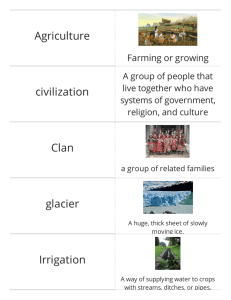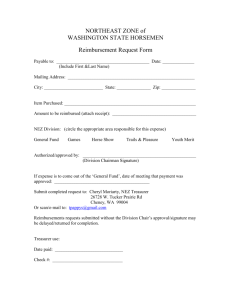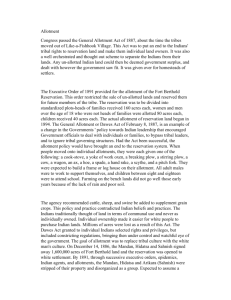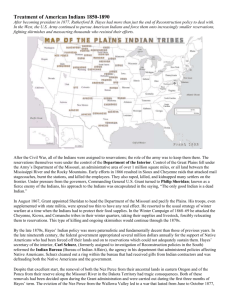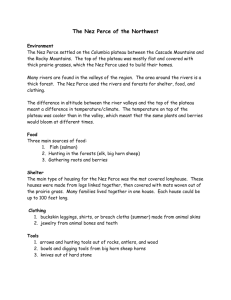to read an outline of this week's lecture, and key questions.
advertisement
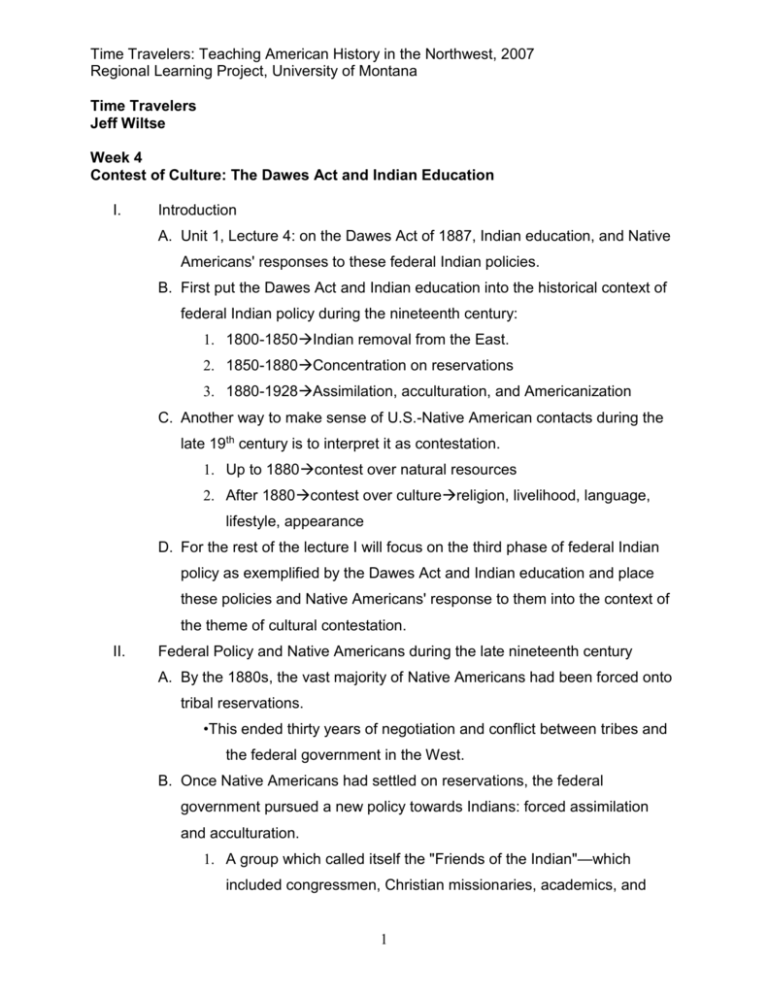
Time Travelers: Teaching American History in the Northwest, 2007 Regional Learning Project, University of Montana Time Travelers Jeff Wiltse Week 4 Contest of Culture: The Dawes Act and Indian Education I. Introduction A. Unit 1, Lecture 4: on the Dawes Act of 1887, Indian education, and Native Americans' responses to these federal Indian policies. B. First put the Dawes Act and Indian education into the historical context of federal Indian policy during the nineteenth century: 1. 1800-1850Indian removal from the East. 2. 1850-1880Concentration on reservations 3. 1880-1928Assimilation, acculturation, and Americanization C. Another way to make sense of U.S.-Native American contacts during the late 19th century is to interpret it as contestation. 1. Up to 1880contest over natural resources 2. After 1880contest over culturereligion, livelihood, language, lifestyle, appearance D. For the rest of the lecture I will focus on the third phase of federal Indian policy as exemplified by the Dawes Act and Indian education and place these policies and Native Americans' response to them into the context of the theme of cultural contestation. II. Federal Policy and Native Americans during the late nineteenth century A. By the 1880s, the vast majority of Native Americans had been forced onto tribal reservations. •This ended thirty years of negotiation and conflict between tribes and the federal government in the West. B. Once Native Americans had settled on reservations, the federal government pursued a new policy towards Indians: forced assimilation and acculturation. 1. A group which called itself the "Friends of the Indian"—which included congressmen, Christian missionaries, academics, and 1 Time Travelers: Teaching American History in the Northwest, 2007 Regional Learning Project, University of Montana reformers—concluded that the U.S. had treated Native Americans terribly in the past and that what was now best for Native Americans was for them to be civilized and assimilated into the American nation. a. This meant becoming private land holders, farmers, and Christians, living in nuclear families, and eventually becoming citizens. b. By becoming private property landowners, farmers, and Christians, Friends of the Indian believed that Native Americans “would naturally flow into the mainstream of American life, become citizens, and learn the value of hard work and wage earning.” 2. To bring this transformation about, the "Friends of the Indian" believed that tribes had to be disbanded, because they promoted a communal identity rather than the individual sense of self that nineteenth century Americans valued. a. Furthermore, tribal cultures and tribal identities had to be eradicated as well. b. In short, the policy of assimilation represented a frontal assault on Indian culture and traditional social organization. C. Dawes Severalty Act (1887) 1. The centerpiece of the assimilation policy was the Dawes Severalty Act, which Congress passed in 1887. a. The assumption of many Friends of the Indian was that the reservation system perpetuated the dependence of Native Americans by inhibiting them from adopting modern and "civilized" ways that would lead to self-sufficiency. •The key to modern, civilized life and self-sufficiency, they believed, was the private ownership of property. This would unleash in Native Americans the acquisitiveness 2 Time Travelers: Teaching American History in the Northwest, 2007 Regional Learning Project, University of Montana necessary for them to survive and prosper in the modern world. •The commissioner of Indian affairs at the time advised that, “tribal relations should be broken up, socialism destroyed and the family and autonomy of the individual substituted. The allotment of land in severalty, the establishment of local courts and police, the development of a personal sense of independence and the universal adoption of the English language are means to this end.” b. And so, the act divided reservation lands, which had been communally held by the tribe, into private property allotments. 2. The provisions of the act were as follows: a. Indian heads of household (adult men) received 160 acres of land, unmarried adults 80 acres, and children 40 acres. •Tribal members were able to choose their individual allotments, but if they refused to do so, their allotments were chosen for them. •The private allotments were also put in trust for 25 years, meaning that Indians could not sell their land for that period. b. The bill also allowed for Indian property owners to become U.S. citizens if they adopted the “habits of civilized life,” meaning if they became farmers. c. The remaining tribal land was then made available for sale to non-Indians. d. Finally, the tribes did not get to choose whether they wanted their reservation lands divided into private allotments. •The decision rested with the federal government. 3 Time Travelers: Teaching American History in the Northwest, 2007 Regional Learning Project, University of Montana •And yet, there was some effort made in Congress to only break up tribes that welcomed allotment. •That said, many tribes that did not want their land allotted were still broken up. 3. The proponents of the bill were well-meaning within their own cultural world view a. Henry Dawes, sponsor of the bill explained its purpose this way: “I trust that we will wipe out the disgrace of our past treatment, and lift [Indians] up into citizenship and manhood, and cooperation with us to the glory of the country.” Indians have been “wronged long enough,” he concluded. b. To Dawes and other "Friends of the Indian," the act was a generous gift of civilization, salvation, and citizenship. c. It should also be mentioned here that other Americans who advocated passage of the Dawes Act were less wellintentioned. •Westerners wanted to get access tribal lands and the natural resources on tribal lands. •Merchants and businessmen who lived near reservations desired the increased commerce that would result from white settlement and putting money in the pockets of Indians. •Many congressmen resented the rising cost of federal management of Indian reservations and saw the Dawes Act as a way to cut expenses. 4. Many Native Americans rejected the idea of allotment and opposed passage of the Dawes Act, preferring to retain whatever was left of their traditional way of life. a. Some Native Americans tried to travel to Washington to express their opposition directly to Congress. 4 Time Travelers: Teaching American History in the Northwest, 2007 Regional Learning Project, University of Montana b. In response, the Commissioner of Indian Affairs John Atkins ordered Indian agents to arrest Native Americans who tried to leave the reservation for this purpose. 5. Ultimately, the Dawes Act had devastating consequences for Native Americans. a. By 1900, Indians had lost nearly 50 percent of their tribal lands. b. By 1934, they had lost two-thirds of their tribal lands. •Native American land base decreased from 150 million acres in 1887 to 48 million by 1934. c. Furthermore, 50 percent of Indians who lived on allotted reservations were landless by the early 1930s. •The act had clearly not promoted independence and selfsufficiency. d. One of the tragic ironies of the Dawes Act was that it tried to force Native Americans into becoming farmers during one of the worst periods for agriculture in U.S. history. •The 1880s and 1890s were disastrous years for agriculture in America. -Dramatic declined in crop prices made farming unprofitable in many parts of the South and West. -As a result, tens of thousands of established farmers went bankrupt and lost their land. •Not an auspicious time to start American Indians as settled farmers. D. Indian Education 1. The second primary means the federal government employed to “Americanize” Indians during the late nineteenth century was through education. 5 Time Travelers: Teaching American History in the Northwest, 2007 Regional Learning Project, University of Montana a. The federal government and Christian missionary societies set up reservation schools and boarding schools for Native American children. b. The first and most famous of these schools was the Carlisle School founded in 1879 and located in central Pennsylvania. c. By 1900, the government operated 148 Indian boarding schools and 225 Indian day schools that enrolled approximately 20,000 Native American students each year. 2. As Richard Pratt, the founder of the Carlisle School put it, the purpose of these schools was to “kill the Indian . . . and save the man.” a. To that end, the schools forbade Indian languages, clothing styles, and even hair fashions. •Before and after photographs. b. Students had to choose a new western name from a list written on the board. •One young student named Plenty Kill chose the name Luther, which suggests that names available were good Protestant ones. c. In classes, students were taught English, U.S. history, and civics; as well as occupational skills such as farming. d. The students were also explicitly taught that Indian ways were wrong and Indian culture was primitive. 3. The “American Experience” video “In the White Man’s Image” does a good job on federal Indian education. E. Native Americans responded variously to forced assimilation and acculturation. 1. Some Indians willingly accepted it. a. After initial trepidation, Nez Perce Indians who lived around the village Kamiah willingly accepted allotment and worked with the allotment agent and surveyor to divide up the land. 6 Time Travelers: Teaching American History in the Northwest, 2007 Regional Learning Project, University of Montana b. Many Native Americans responded favorably to education opportunities as well. •For example, Plenty Kills’ father Standing Bear insisted that his son learn the ways of the "Long Knives," assuming that was the best way to cope with the current predicament. c. By the early twentieth century, Indians schools had produced a significant number of highly educated Indians who had assimilated into white society. •They became something of an Indian intelligentsia. •Most advocated continued government efforts at assimilation but also greater respect for traditional Indian culture. •Several founded the Society of American Indians and started publishing a journal titled Quarterly Journal. -Articles out of this make for good primary source reading, but from elite voices. -They capture the ambivalence of the Indian intelligentsia. 2. Many Native Americans seemed to have passively resisted assimilation. a. They simply did not settle on their allotted land and refused to take up farming. b. Instead, they continued to hunt and raise livestock. c. Great article on the Ute Indians’ passive resistance to the Dawes Act (David Rich Lewis, “Environment, Subsistence, and Dependency: Farming and the Northern Ute Experience, 1850-1940) 3. Still other Native Americans resisted the assault on their traditional ways in a more direct and organized way. 7 Time Travelers: Teaching American History in the Northwest, 2007 Regional Learning Project, University of Montana a. Best example is the Ghost Dance religion, which peaked in 1890. b. Ghost Dance originated when a Sioux prophet had a vision in which the Creator told him that divine judgment was coming and Indian peoples would be granted a special place in the afterlife. •They would return to their lost world on the plains before the coming of whites. •Buffalo would once again be abundant. c. The religion spread through the Sioux tribe and to Native Americans in other tribes as well. •Thousands of Sioux would gather and dance themselves into exhaustion. •It was a rejection not just of assimilation but of the presence of whites. d. In order to stop the spreading religion, the U.S. dispatched the 7th Calvary to the Pine Ridge Reservation. •Led by Sitting Bull, the Sioux escaped into the Bad Lands of South Dakota. •The 7th Calvary finally apprehended them at Wounded Knee Creek. •The Indians surrendered but during the surrender one warrior named Yellow Bird refused to give up his gun. A struggle ensued with an officer and the gun discharged killing the officer. •The 7th Calvary responded with machine gun fire, killing 200. e. Unlike earlier battles between U.S. troops and Native Americans, this fight was not over land and other natural resources but rather over religious practices and beliefs. 8 Time Travelers: Teaching American History in the Northwest, 2007 Regional Learning Project, University of Montana •This exemplifies the cultural contestation that characterized U.S.-Native American contact during the late nineteenth century. III. Dawes Act in the Northwest A. The Dawes Act was a general allotment act 1. Meaning that it empowered the federal government to break up reservations, but it did not actually do so to any specific reservations. 2. Congress had to pass additional acts to allot specific reservations. a. Nez Perce Reservation in 1887 b. Flathead Reservation in 1904 B. Allotment of Northwest Tribes 1. There are a couple good article and chapter length studies of the allotment of tribal reservations in the Northwest: a. On the allotment of the Flathead Reservation, see Burton M. Smith, "The Politics of Allotment: The Flathead Indian Reservation as a Test Case," Pacific Northwest Quarterly (July 1979), 131-139. b. On the allotment of the Nez Perce Reservation, see Emily Greenwald, Reconfiguring the Reservation: The Nez Perces, Jicarilla Apaches, and the Dawes Act (University of New Mexico Press, 2002). 2. It is difficult to generalize about the allotment of Northwest reservations because different reservations were allotted at different times and under different circumstances. a. Furthermore, Native Americans on different reservations and even within the same reservation responded differently to allotment. 3. Rather than try to generalize about allotment on NW reservations, I will focus on the application of the Dawes Act to the Nez Perce Reservation in Idaho. 9 Time Travelers: Teaching American History in the Northwest, 2007 Regional Learning Project, University of Montana C. Allotment of the Nez Perce Reservation 1. This is a rich and complex story that I will only be able to provide a brief outline of. a. For a more complete account, see Emily Greenwald's Reconfiguring the Reservation. 2. The Nez Perce Reservation was one of the first reservations in the nation targeted for allotment. a. President Grover Cleveland included the Nez Perce on the first list of tribes to be allotted in 1887, the same year as the general allotment act was passed. b. Two primary reasons the Nez Perce lands were allotted so early: •Many Nez Perce had nominally accepted Christianity and so federal officials assumed they were willing to adopt an agrarian lifestyle. •Whites living in Idaho immediately pressured the federal government to give them access to the resources within the reservation's boundaries. c. The surveying of the Nez Perce reservation began in 1889. •The government assigned anthropologist Alice Fletcher to carry out the allotment. -Fletcher was married to Henry Tibbles, an Omaha Indian, and was generally sympathetic to the interests of Nez Perce Indians. -Unlike some other agents charged with carrying out allotment, Fletcher was inclined to make the Dawes Act work to Indians' advantage. •When Fletcher arrived on the reservation in 1889, however, the Nez Perce professed to know nothing about the Dawes Act and the break up of their lands into private property holdings. 10 Time Travelers: Teaching American History in the Northwest, 2007 Regional Learning Project, University of Montana •As a result, they greeted her coolly and at first resisted her attempts to sign individual Indians for allotted land. d. Divided response among the tribe •Eventually, a group of Nez Perce that lived around the village of Kamiah agreed to choose allotments after the local Nez Perce minister--Robert Williams--chose a parcel of land for his family. -This group of Nez Perce was predisposed to accept allotment because many of them already lived on and farmed small parcels of land. •The Nez Perce that lived around the Lapwai community, however, remained opposed to allotment, but they did so for perhaps surprising reasons. -The federal government's local Indian agent was based in Lapwai and many local men had jobs through the agency. If the tribe was broken up and the federal control over the reservation was ended, those jobs would disappear. -Lapwai Nez Perce also rejected allotment because several of them owned livestock owners and benefited from grazing their cattle on the commonly held tribal lands. Allotment would effectively end this practice by breaking up the common lands. •Fletcher eventually overcame Lapwai resistance by obtaining an order from the Commission of Indian Affairs prohibiting unalloted Indians from leaving the reservation to hunt, which the Nez Perce did for several months each year. -Faced with losing this traditional practice the Lapwaians dropped their opposition. 11 Time Travelers: Teaching American History in the Northwest, 2007 Regional Learning Project, University of Montana -As this example shows, even Fletcher was not averse to using coercion. 2. Main points about the actual allotment a. Individual Nez Perce Indians got to choose what parcels of land they wanted. •And, Fletcher created many oddly shaped allotments in order to accommodate Nez Perces' desires. •For example, many Nez Perces wanted to keep small tracts of land they occupied close to the river and take the rest of their allotted land upon on the prairie, demands that Fletcher accommodated. •In short, Nez Perces had considerable say in the process of allotment. b. The Nez Perce believed that by accepting allotted land, they were not giving up previous treaty rights that permitted them to hunt and fish on a much larger area outside the reservation. •As would become clear later, most Nez Perce did not want to become settled farmers but rather wanted to continue the traditional practice of leaving the reservation to hunt and fish during the summer months. c. At the end of the initial allotment in 1892, Nez Perce retained only 27 percent of the reservation, leaving the remaining 73 percent of reservations lands vulnerable to sale to whites as "surplus." 3. Sale of "surplus" land to non-Nez Perces a. After land for tribal members had been allotted, the federal government sent agents to negotiate with the tribe for the sale of surplus lands. 12 Time Travelers: Teaching American History in the Northwest, 2007 Regional Learning Project, University of Montana b. Just as they were divided in their response to allotment, Nez Perces were also divided in their response to the selling of surplus land to non-Indians. •The poorer class of Nez Perces mostly favored the sale because the money they would receive would enable them to pay off debts and, at least for the short term, improve their standard of living. •More well-to-do tribal members, especially those who owned livestock that grazed on the commonly held tribal lands, opposed sale of the land because they would lose access to the unallotted lands. c. Eventually, federal agents convinced a majority adult males to sign an agreement approving the sale of surplus land to the federal government. •Unclear if any coercion was involved. •The Nez Perces received $1.6 million in exchange for 542,000 acres of unallotted land, which was distributed among tribal members. d. The federal government then made the land available to non-Indians in 1895. 4. Nez Perces made many uses of their allotted land a. Some Nez Perces did indeed become settled farmers. •In 1908, for example, about 300 Nez Perces cultivated farms totally about 5,000 acres. b. Many Nez Perces leased their lands to whites and tried to maintain their more traditional subsistence lifestyle of hunting and fishing. •This became increasingly difficult, however, as state and federal officials restricted Nez Perces access to traditional hunting and fishing grounds. 13 Time Travelers: Teaching American History in the Northwest, 2007 Regional Learning Project, University of Montana •Furthermore, the value of leased land decreased as it became over farmed. c. Over time, Nez Perce holdings dwindled. •After 1906, when Congress amended the Dawes Act to allow "competent" Indians to sell their allotments, some Nez Perce sold their land. •Allotment holdings eventually became sub-divided as land passed down from parents to children to grandchildren. 5. Long term consequences a. The long term consequences of allotment were catastrophic for the Nez Perces •Loss of their land base •Loss of their traditional ways b. Writing in the 1930s, Nez Perce anthropologist Archie Phinney explained that allotment had created two economic classes within his tribe--the landed who "subsist on their meager lease revenues" and the landless who "have no unearned income, who are sometimes day laborers but more often simply appendages of Indian families able to support them." c. By 2002, Nez Perces controlled only 88,000 acres of their original reservation, which before allotment totaled 747,000 acres. •The Nez Perces to date have lost approximately 88 percent of their land. •Allen Slickpoo, a member of the Nez Perce tribe, wrote in 1970 that he "has known a number of people who have grown up within the boundaries of the reservation who had no idea they were living anywhere near an Indian reservation." 14 Time Travelers: Teaching American History in the Northwest, 2007 Regional Learning Project, University of Montana 6. The Dawes Act certainly brought the Nez Perces into extensive contact with non-Indians, but it clearly did not lead to widespread self-sufficiency. 15
